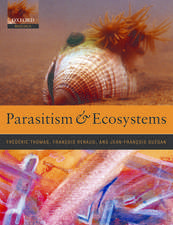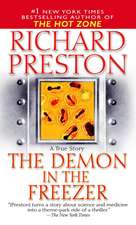Comparative Biochemistry of Parasitic Helminths
Editat de Eva Bennetten Limba Engleză Paperback – 3 oct 2013
Preț: 382.18 lei
Nou
Puncte Express: 573
Preț estimativ în valută:
73.14€ • 75.56$ • 60.87£
73.14€ • 75.56$ • 60.87£
Carte tipărită la comandă
Livrare economică 25 martie-08 aprilie
Preluare comenzi: 021 569.72.76
Specificații
ISBN-13: 9789401068611
ISBN-10: 9401068615
Pagini: 192
Ilustrații: VIII, 180 p. 2 illus.
Dimensiuni: 155 x 235 x 10 mm
Greutate: 0.28 kg
Ediția:Softcover reprint of the original 1st ed. 1989
Editura: SPRINGER NETHERLANDS
Colecția Springer
Locul publicării:Dordrecht, Netherlands
ISBN-10: 9401068615
Pagini: 192
Ilustrații: VIII, 180 p. 2 illus.
Dimensiuni: 155 x 235 x 10 mm
Greutate: 0.28 kg
Ediția:Softcover reprint of the original 1st ed. 1989
Editura: SPRINGER NETHERLANDS
Colecția Springer
Locul publicării:Dordrecht, Netherlands
Public țintă
ResearchCuprins
1 Ascris suum: a useful model for anerobic mitochondrial metabolism and the transition in aerobic-anaerobic developing parasitic helminths.- 2 The role of 5-hydroxytryptamine (5-HT: serotonin) in glucose transport, intermediary carbohydrate metabolism and helminth neurobiology.- 3 What are the functions of the catecholamines and 5-hydroxytryptamine in the parasitic nematodes?.- 4 The physiological significance of Complex II (succinate-ubiquinone reductase) in respiratory adaptation.- 5 Oxygen and the lower Metazoa.- 6 How do parasitic helminths use and survive oxygen and oxygen metabolites?.- 7 Carbohydrate and energy metabolism in adult schistosomes: a reappraisal.- 8 Using carbon-13 Nuclear Magnetic Resonance spectroscopy to study helminth metabolism.- 9 Detoxification reactions in parasitic helminths.- 10 Parasite transport and inactivation functions involved in antiparasitic efficacy.- 11 The molecular biology of drug resistance in parasitic helminths.- 12 Comparative biochemistry of parasites and its role in drug resistance—an investigation of species differences in tubulin.- 13 Systemic effects of helminth infections as revealed by serum LDH isozymes and kinetic parameters of transport (Vmax and K1) of the host tissue.- Helminth index.








